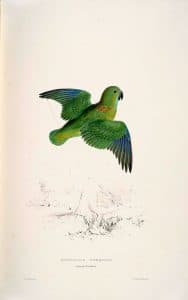Content |
|---|
Description
15 cm.. length between 62 and 77 g. of weight.
The head of the Guaiabero (Bolbopsittacus lunulatus), is mainly green, strongly impregnated of color blue light around them eyes, in the lores, the chin and (vaguely) on throat. Mantle slightly of a green over dark that it crown, bordered above pale yellowish green.
Primary coverts blue; the others wing-coverts, greenish. The flight feather with the vane bluish external, alula bluish. Uppertail bright green, great coverts Underwing bordered with yellow; rest of the underwings with pale yellow bar in all vane internal of flight feather (except the primaries outermost). Underparts uniform Green, slightly paler which the upperparts. Tail closed from color green bright by over, pale blue below.
Bill greyish black; irises dark brown; legs gray.
The female much less blue sign in the face, and has yellowish the part back from the neck and rump, both showing darker scalloped.
Immature are like females, but with the bill lighter.
- Sound of the Guaiabero.
Subspecies description
-
Bolbopsittacus lunulatus lunulatus
: (Scopoli, 1786) – Nominal
-
Bolbopsittacus lunulatus callainipictus
: (Parkes, 1971) – The male is like the intermedius, but with the plumage, in general, more yellow, above all in the underparts; face and neck nuchal darker and more bluish green; cheeks with less blue. The female as in the intermedius, but in general with more plumage yellow; rump and the nuchal collar more yellow and brighter. The youth adult females are.
-
Bolbopsittacus lunulatus intermedius
: (Salvadori, 1891) – The face male is dark blue tinged with purple; neck brilliant blue. Female bordered blue in the throat; cheeks pale green; Green more pale around them eyes; neck yellow-orange. The youth are like the female adult.
-
Bolbopsittacus lunulatus mindanensis
: (Steere, 1890) – The cheeks of the male are green, Blue around them eyes, Blue throat; neck darker and brighter blue than the lunulatus; yellow tint to green in the head. The female as of the lunulatus, but the head tinted yellowish-green. The youth adult females are.
Habitat:
It inhabits in open forests, forests and their surroundings, secondary vegetation, Savannah, farmland, gardens and mangroves, in the lowlands up to approximately 600 meters above sea level. Birds congregate in fruit trees sometimes in groups of up to 50 Member. Easier to detect in flight. While feeding they move silently and can be difficult to locate..
Reproduction:
The ecology of the species is poorly understood.. A female in breeding conditions It was observed during the month of March.
Food:
The diet includes fruit, especially the guavas (Psidium guajava)
Distribution:
Size of the area of distribution (reproduction / resident): 212.000 km2
Limited to the lowlands of the Philippine Islands, including Luzon, Mindanao, Samar, Leyte and Panaon.
Distribution of the subspecies:
-
Bolbopsittacus lunulatus lunulatus
: Nominal
-
Bolbopsittacus lunulatus callainipictus
: Samar (central Philippines)
-
Bolbopsittacus lunulatus intermedius
-
Bolbopsittacus lunulatus mindanensis
: Mindanao (Southern Philippines)
Conservation:
• Current IUCN Red List category: Least concern
• Population trend: Stable
The size of the world population It has not been quantified, Although estimated at more of 50.000 specimens. The species, according to sources, it is enough common in all its limited area of distribution (pit et to the. 1997).
The population suspected to be stable in the absence of evidence of any reduction or substantial threats.
"Guaiabero" in captivity:
Almost unknown in captivity.
Parrot quiet and gentle. Sensitive to stress and infections, primarily by protozoa. Strict hygiene is necessary to protect this species of infectious diseases. They must be kept in pairs.
Alternative names:
– Guaiabero (ingles).
– Guaiabero lunulé, Perruche lunulée, Psittacule lunulée (French).
– Stummelschwanzpapagei (German).
– Guaiabero (Portuguese).
– Lorito Guayabero, Lorito Guayabo (español).
scientific classification:
– Order: Psittaciformes
– Family: Psittaculidae
– Genus: Bolbopsittacus
– Scientific name: Bolbopsittacus lunulatus
– Citation: (Scopoli, 1786)
– Protonimo: Psittacus ephypium
Images "Guaiabero"
Videos "Guaiabero"
“Guaiabero” (Bolbopsittacus lunulatus)
Sources:
- Avibase
- Parrots of the World – Forshaw Joseph M
- Parrots A Guide to the Parrots of the World – Tony Juniper & Mike Parr
- Birdlife
Photos:
(1) – Guaiabero (Bolbopsittacus lunulatus) By Luis V. Limchiu [CC BY-SA 3.0, GFDL or Public domain], via Wikimedia Commons
(2) – A painting of a green parrot by Edward Lear. It looks like a female Guaiabero (Bolbopsittacus lunulatus) Edward Lear [Public domain], via Wikimedia Commons
Sounds: Paul Noakes (Xeno-canto)



